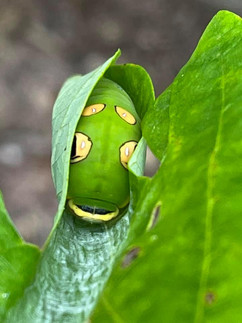Family: Lauraceae
Name: Sassafras albidum - Sassafras
Top Row: Flower, Early Foliage
Second Row: Spicebush Swallowtail Caterpillar hiding during the day by curling itself up in a leaf, Fall Color, Botanical Drawing
Bloom Time: April - May
Flower: Greenish yellow
Soil Condition: Moist, Well Drained, Acidic
Light: Sun, Partial Shade
Height: 30-50' tall by
Native Range: Eastern North America including Long Island
Zone: 4 to 9
Sassafras albidum has three different leaf shapes all present at the same time, mitten shaped, oval and three-lobed. It forms a small colony by root suckers. The flowers (starting at age 10) are quite showy on the female tree and birds love the dark blue berries that form on the ends of bright red stalks in the summer. Fall foliage is a fiery mix of oranges and reds. Winter twigs may be red, green or brown depending on its age.
Fun Facts: Bark may be used to make orange dye. Tea may be made from young roots. Other common name is Mitten Tree because some of the leaves are shaped like mittens. Stem pith called filé is used to thicken gumbo. Aromatic oil extracted from the bark is used for perfume and soap.
Maintenance: Laurel Wilt may be a problem. To train as a single trunk, remove root suckers.
Benefits: Host plant to Spicebush Swallowtail, Tiger Swallowtail, Promothea Silk Moth and 35 other species of butterflies and moths, pollinated by small bees and flies, juglone tolerant (Black Walnut), moderately deer and rabbit resistant, drought tolerant
Companion Plants: Quercus species (Oak), Eurybia divaricata (White Wood Aster), Solidago odora (Sweet Goldenrod), Gaylussia baccata - Huckleberry
pictures: KMS Native Plants, Missouri Department of Conservation
illustration: Missouri Department of Conservation
=============================================================
References:











Comments